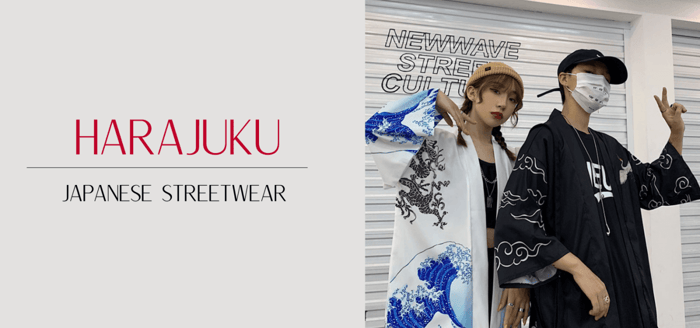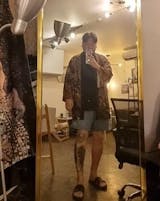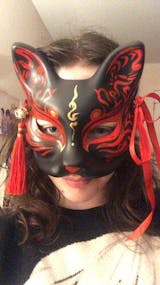If you have a deep appreciation for both traditional and modern Japanese styles, you've come to the perfect place. Here, we will delve into the world of popular Japanese streetwear trends and explore the distinctive elements that define these fashion movements.
In recent years, Japanese streetwear has taken the fashion world by storm. With its unique blend of traditional aesthetics and contemporary influences, Japanese streetwear has become a global phenomenon. From the streets of Harajuku to the runways of Paris, this style has captivated fashion enthusiasts worldwide.
In this blog post, we will get into six important Japanese streetwear items that have gained popularity and continue to influence fashion trends. Each style represents a different facet of Japanese culture, showcasing the country's rich heritage and innovative spirit. Whether you're a fashion enthusiast or simply intrigued by Japanese culture, join us as we explore the vibrant world of Japanese streetwear.
Japanese streetwear is a current, gender-neutral fashion that has gained popularity in Tokyo's Harajuku neighborhood. It is intended to defy the conventions of Japanese culture and be informal and unique.
It's time to understand the benefits of this Japanese approach to success. Let's explore Tokyo's fashion district!

Here's a glimpse into the various clothing pieces that exemplify Japanese styles.
Japanese streetwear encompasses a wide range of styles that fuse traditional Japanese clothing with modern influences. One popular style is the Haori, a traditional Japanese jacket often worn over a kimono.
Haori jackets have become a staple in streetwear fashion due to their loose and relaxed fit, as well as their intricate patterns and vibrant colors. They are often paired with jeans or street-style bottoms for a contemporary look.
Sukajan is the Japanese version of a bomber jacket. The styles are similar to baseball jackets. They are usually embroidered with animals, and patterns and made of the finest silk
Hakama is a traditional Japanese skirt-like garment that has made its way into streetwear fashion. Modern adaptations of hakama feature sleek designs and are often paired with t-shirts or hoodies. The combination of the traditional silhouette with modern streetwear elements creates a unique and edgy look.
Tabi Socks are a distinctive feature of Japanese streetwear. These socks have a separation between the big toe and the other toes, allowing them to be worn with traditional Japanese footwear like geta or zori sandals. Tabi socks come in various colors and patterns, adding a playful and eye-catching element to any streetwear ensemble.
Japanese Hats, such as the hachimaki (Japanese headband), docker cap, and boonie hat (bucket hat), have also become popular in streetwear fashion. The hachimaki is a headband often adorned with motivational slogans or symbols, while the boonie hat is a wide-brimmed hat that offers both style and sun protection. These hats are often paired with other streetwear pieces to create a fashion-forward and culturally-influenced look.
Japanese Masks for festivals, such as the Hannya mask or the Kitsune mask, have made their way into streetwear fashion as well. These masks, traditionally used in theater and folklore, are now incorporated into streetwear outfits to add a touch of mystique and intrigue. They are often used as accessories or displayed as prints on clothing.
Japanese streetwear styles like the haori, hakama, tabi socks, Japanese hats, and Japanese masks for festivals offer a blend of traditional and contemporary elements. They showcase the rich heritage of Japanese culture while embracing innovation and creativity. By incorporating these styles into their outfits, fashion enthusiasts can create unique and visually captivating looks that pay homage to Japan's vibrant streetwear scene.
The History of Japanese Streetwear Fashion
The history of Japanese streetwear style is a fascinating journey that combines elements of cultural expression, subcultures, and global influences. To fully understand its origins, we must delve into various key factors that shaped this unique fashion movement.
Japanese streetwear draws inspiration from a diverse range of sources, both domestic and international. One significant influence comes from Japan's own rich history of traditional clothing, such as the kimono, yukata, and hakama. These garments have a timeless elegance and exquisite craftsmanship, often serving as the foundation for modern interpretations in streetwear.
However, the emergence of Japanese streetwear as a distinct style can be traced back to the late 20th century. It gained momentum in the 1980s and 1990s, primarily through the influence of subcultures like the Harajuku fashion scene in Tokyo. Harajuku became a hub for alternative fashion, with its colorful and eccentric street styles captivating both locals and international visitors.
The Harajuku fashion movement introduced a mix of Western and Japanese influences, challenging traditional notions of dress and self-expression. It embraced individuality, creativity, and experimentation, inspiring a generation of young people to adopt unique and unconventional styles. The movement quickly spread beyond Harajuku, influencing streetwear trends throughout Japan and the world.
Japanese streetwear gained further recognition and popularity in the 1990s with the rise of prominent streetwear brands like A Bathing Ape (BAPE) and Undercover. These brands infused Japanese aesthetics with elements of hip-hop culture, creating a fusion of urban and avant-garde styles. Their bold graphics, vibrant colors, and innovative designs attracted a wide range of fashion enthusiasts, including musicians, artists, and trendsetters.
Gold Dragon Kimono Cardigan
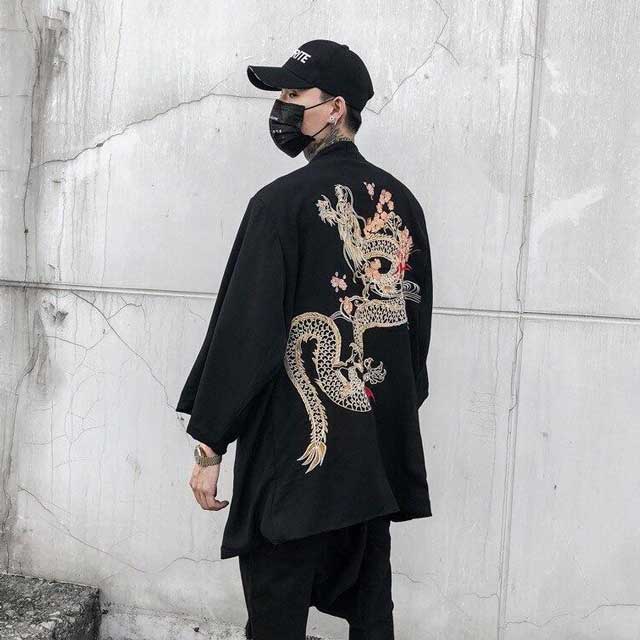
$40.90
From Myth to Modern: The Black Kimono Cardigan That Commands Attention Step into the realm of the chic and the timeless with this Black Kimono Cardigan, an embodiment of classic style with a bold edge. The garment is a modern… read more
Today, Japanese streetwear continues to evolve and diversify. It embraces a wide range of influences, from retro and vintage aesthetics to futuristic and high-tech elements. Japanese designers and brands are renowned for their attention to detail, craftsmanship, and commitment to pushing boundaries.
In terms of who wears Japanese streetwear, it is not limited to a specific demographic or age group. It appeals to a wide spectrum of individuals who appreciate its unique aesthetics and cultural significance. Japanese streetwear has a global following, with enthusiasts from various countries incorporating its elements into their personal style.
When it comes to wearing Japanese streetwear, there are no strict rules or limitations. It can be incorporated into everyday outfits, special occasions, or even professional settings, depending on the specific pieces and how they are styled. Japanese streetwear offers a versatile range of clothing options, including graphic T-shirts, oversized hoodies, baggy pants, unique sneakers, and statement accessories.
To conclude, the history of Japanese streetwear style is a testament to the dynamic fusion of cultural influences, subcultures, and artistic expression. Its origins in the Harajuku fashion scene, the blending of traditional and modern elements, and the global reach of influential brands have all contributed to its enduring popularity. Japanese streetwear continues to captivate fashion enthusiasts worldwide with its distinctive aesthetics and ability to constantly reinvent itself.
Traditional Influences & Style
Traditional Japanese culture has also greatly influenced streetwear styles. Kimono, a traditional Japanese garment, has found its way into modern fashion, creating a unique blend of tradition and contemporary design. Kimono-inspired jackets, known as "haori," have become a popular staple in streetwear. These jackets feature intricate patterns, rich colors, and flowing silhouettes that pay homage to Japan's cultural heritage. Alongside kimono-inspired pieces, streetwear brands often incorporate traditional Japanese motifs such as cherry blossoms, dragons, and waves into their designs. This fusion of traditional elements with streetwear aesthetics showcases a deep appreciation for Japan's history and cultural legacy.
Haori jackets also called kimono cardigans. The fashionable alternative to sweaters is the kimono cardigan. They have a deep V-neck and wrap around the chest. The V-neck lengthens the neck, and the wraparound effect conceals love handles, making them look more upscale and feminine than sweaters. The design supports the idea of universal sizing and is forgiving and cozy. There is plenty of cloth, but by tightening the belt, the size is adjusted for a snug fit. Although there are some types that button up, tying the kimonos closed is more typical. However, the designs are more important than the closure. The vibrant and lovely traditional Japanese designs are adored by people everywhere.
Did you know that these patterns go beyond being aesthetically pleasing? Every shade and pattern can possibly imply something more. You might decide on a specific meaning for someone important or pick one of the following for yourself.
Giving your child a Koi fish pattern in a standout hue, for instance, may ensure success in their tests. To show your support for your friend through a difficult period, you might purchase them a tortoise design.
$54.90
Become The Centre of Attention With This Black Kimono Cardigan Step into the realm of bold aesthetics with our dynamic Kimono Cardigan, a masterpiece that marries the fierce spirit of traditional Japanese motifs with contemporary fashion flair. Tailored from top-tier… read moreBlack Oni Kimono Cardigan
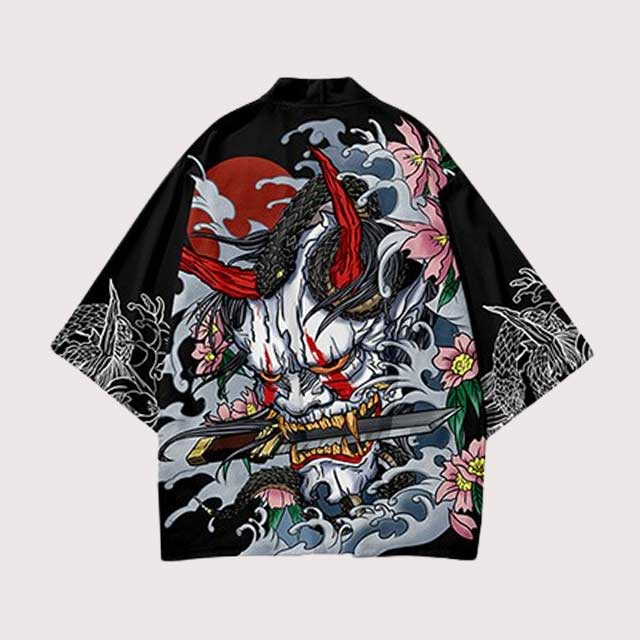
$64.90
HAKAMA PANTS
Wide-leg pants with an ankle-length hem are known as hakama pants. They were primarily worn by members of Japan's upper classes with a short kimono called a kimonoshita tucked inside them. They are sometimes referred to as "divided skirts" because they have a divided flap-like panel in the front and back. Traditional clothing was typically made of natural materials like cotton, wool, and silk.
Modern Hakama Pants
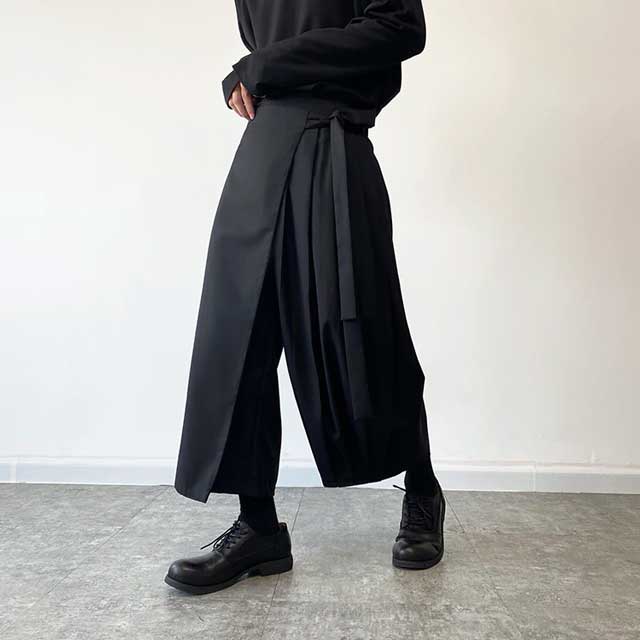
$84.99
$94.90
Fusion Fashion: Modern Hakama Pants for the Trendsetter! Discover a fusion of tradition and contemporary style with our Modern Hakama Pants. These pants redefine elegance and comfort, bringing a unique twist to your wardrobe. Crafted from high-quality fabric, the modern… read more
In contrast, contemporary hakama are typically made of synthetic materials to make it simpler to hold the pleats, which are an essential component of the hakama aesthetic.
Although hakama are available in a variety of colors, it is simpler to obtain plain or striped versions in shades of white, black, gray, and navy.
SUKAJAN JACKETS
Originally created in the post-World War II era by American soldiers stationed in Japan, the Sukajan was a way for them to commemorate their time in the country. Over time, these jackets became popular among Japanese youth and eventually evolved into a symbol of Japanese street fashion.
The Sukajan jacket has become a highly sought-after item in the world of streetwear due to its bold and striking aesthetic. It has gained international recognition, with fashion enthusiasts around the globe embracing this unique Japanese style. Sukajan jackets can be paired with various streetwear pieces, such as jeans, joggers, or even skirts, to create a stylish and edgy look.
By incorporating a Sukajan jacket into their wardrobe, individuals can showcase their appreciation for Japanese culture while making a bold fashion statement. Sukajan's fusion of Eastern and Western elements embodies the spirit of Japanese streetwear, where traditional aesthetics meet contemporary trends. Whether worn by locals in the bustling streets of Tokyo or fashion enthusiasts worldwide, the Sukajan has undeniably become an iconic symbol of Japanese streetwear style.
JAPANESE MASKS
KITSUNE MASK
Kitsune masks, also known as fox masks, are an essential component of Japanese culture and may be found in a wide variety of pop culture, mythology, art, drama, and religious settings. In reality, far before the era of the samurai, geisha, or even the shogunate, kitsune legends have existed in Japan since at least the 6th century, when Buddhism first arrived and blended with the Shinto religion.
How about Kitsune, though? In English, "fox" or "foxes" is the meaning of the Japanese word "kitsune." The kitsune has constantly been a revered animal in Japanese culture. These foxes have developed supernatural abilities and appeared in a variety of folktale characters.
Masks painted to resemble these fox or kitsune characters are known as kitsune masks. The most well-known of these is a plain white mask with erect ears and striking red and black paint on its features.
Cosplay, Japanese festival activities, kabuki (traditional Japanese theater), as well as anime and cinema, frequently make extensive use of these masks.
ONI MASK
As concepts and symbols evolve throughout history to represent the attitudes and cultures of our contemporary society, their meanings shift.
Oni masks are a striking illustration of how a symbol may evolve through time. This symbol of Japan's rich culture originally served as an evil image, showing devils waiting to entice souls into hell.
Today, though, these beings have a very different significance. An Oni mask, once linked with the "dark side," now grants its wearers strength and power, shielding them from harm. These masks show red-faced Japanese demons with angry expressions and generally two horns.
TECHWEAR STYLE
Techwear, short for "technical wear," is a style that combines fashion with functionality. It focuses on performance-driven garments that seamlessly integrate technology into their design. Waterproof fabrics, modular features, and utility pockets are common in techwear. This style emerged as a response to the urban lifestyle, addressing the need for clothing that adapts to the demands of the modern world. With its sleek and futuristic aesthetics, techwear represents a fusion of fashion, functionality, and innovation.
To conclude this, blog post, Japanese streetwear is a diverse and ever-evolving realm of fashion that captivates individuals worldwide. From the colorful and eccentric Harajuku fashion to the sleek and avant-garde Tokyo street style, each style offers a unique perspective on Japanese culture and fashion innovation. Whether drawing inspiration from traditional elements or pushing the boundaries of contemporary design, Japanese streetwear continually evolves, blurring the lines between high fashion and street culture. The influence of Japanese streetwear can be seen across the global fashion landscape, as designers and fashion enthusiasts embrace its unique aesthetics and celebrate the art of self-expression. As the world becomes increasingly interconnected, Japanese streetwear serves as a vibrant and influential force, bridging cultures and inspiring creativity. So, embrace your individuality, express yourself through fashion, and embark on a journey into the captivating world of Japanese streetwear.

